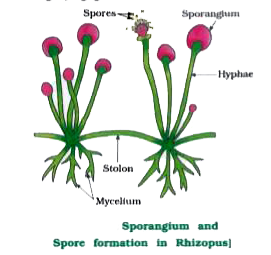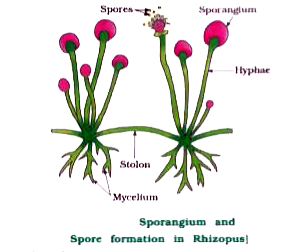When a moist slice of bread was kept aside for a few days then some organism grew on it to form a cottony mass which later turned black. When this slice of bread was observed through a magnifying then fine thread-like projections and thin stems having bulb-like structures at the top were seen.
What are the fine, thread-like projections on the surface of slice of bread known as ?
Step-by-Step Solution:
1. Observation of the Bread: When a moist slice of bread is left aside for a few days, it becomes a suitable environment for certain organisms to grow. This is often due to the presence of moisture and nutrients in the bread.
2. Formation of Cottony Mass: After a few days, you will notice the growth of a cottony mass on the surface of the bread. This mass is typically a fungal growth, which is a common occurrence on moist bread.
3. Change in Color: Over time, this cottony mass may turn black, indicating the maturation of the fungal spores. This is a normal part of the life cycle of fungi.
4. Magnification and Observation: When you observe this mass through a magnifying glass, you will see fine thread-like projections. These projections are part of the fungal structure.
5. Identification of Structures: The fine thread-like projections are known as mycelium. Mycelium is the vegetative part of a fungus, consisting of a network of fine white filaments (hyphae).
6. Bulb-like Structures: Along with the mycelium, you may also observe thin stems with bulb-like structures at the top. These bulb-like structures are known as spores, which are reproductive units of the fungus.
7. Conclusion: Therefore, the fine thread-like projections on the surface of the slice of bread are referred to as mycelium.
Topper's Solved these Questions
- HOW DO ORGANISM REPRODUCEBOOK - BETOPPERSCHAPTER - HOW DO ORGANISM REPRODUCEEXERCISE - WORKSHEET 2
35 Videos
- HOW DO ORGANISM REPRODUCEBOOK - BETOPPERSCHAPTER - HOW DO ORGANISM REPRODUCEEXERCISE - WORKSHEET 3
67 Videos
- HEREDITY & EVOLUTIONBOOK - BETOPPERSCHAPTER - HEREDITY & EVOLUTIONEXERCISE - COMPETITIVE WORKSHEET
34 Videos
- LIFE PROCESSESBOOK - BETOPPERSCHAPTER - LIFE PROCESSESEXERCISE - COMPETITIVE WORKSHEET
82 Videos
Similar Questions
In sexual reproduction of flowering plants, the first event involved in this is.
View SolutionOne of the following is not a part of the human male reproductive system. This is
View SolutionWhich of the following may be used to obtain an F2 generation ?
View SolutionMatch the column I with Column II.

View SolutionWhy does bread mould grow profusely on a moist slice of bread rather than on a dry slice of bread?
View SolutionIn Rhizopus fungus, the fine thread-like structures spread on the whole surface of slice of bread are called :
View SolutionWhen a moist slice of bread was kept aside for a few days then some organism grew on it to from a white, cottony mass which later turned black. When this slice of bread was observed through a magifying glass, Then fine thread-like projections and thin stems having bulb-like structures at the top were seen.
(a) What is the common name and scientific name of the organism which grew on the slice of bread
(b) How did this organism grow on the moist slice of bread automatically?
(c) What are the fine, thread-like projections on the surface of slice of bread known as ?
(d) What name is given to the knob-like structures and what do they contain?
(e) What is the name of this method of reproduction?
(f) Name one unicellular organism which reproduces by this method.
(g) Name two non-flowering plants which reproduce by this method.
View SolutionWhen a moist slice of bread was kept in a cold and dark place for a couple of days, some organisms grew on it to form a fluffy cottony mass which later turned black. On seeing through a magnifying glass some thread like projections and thin filaments having bulb like structures at the tip were observed.
(a) Write the common name of the organism observed. name the mode of reproduction that made the organism grow and spreads over the bread.
(b) Draw the diagram of the organism observed and label its parts.
(c) Name and write anout the structure of the cells that arte responsible for its reproduction.
View SolutionBread mould grows profusely on a moist slice of bread rather than on a dry slice of bread
View SolutionWhy does bread mould grow profusely on a moist slice of bread rather than on a dry slice of bread?
View SolutionWhy does bread mould grow profusely on a moist slice of bread rather than on a dry slice of bread?
View SolutionWhy does bread mould grow profusely on a moist slice of bread rather than on a dry slice of bread?
View SolutionTo observe the growth of fungus-Rhizopus on the piece of bread.
Apparatus : Petridish, Magnifying glass.
Material : Wet slice of bread.
Procedure :
→ Wet a slice of bread in water. Now put the wet plece of bread in petridish. Keep the petridish in dark, moist and cool environment for a week.
→ Now observe the bread slice with help of magnifying glass.

What is seen on the slice of bread ?
View SolutionTo observe the growth of fungus-Rhizopus on the piece of bread. Apparatus : Petridish, Magnifying glass. Material : Wet slice of bread. Procedure : rarr Wet a slice of bread in water. Now put the wet plece of bread in petridish. Keep the petridish in dark, moist and cool environment for a week. rarr Now observe the bread slice with help of magnifying glass. Which fungi grow on the bread ?
View SolutionTo observe the growth of fungus-Rhizopus on the piece of bread.
Apparatus : Petridish, Magnifying glass.
Material : Wet slice of bread.
Procedure :
→ Wet a slice of bread in water. Now put the wet plece of bread in petridish. Keep the petridish in dark, moist and cool environment for a week.
→ Now observe the bread slice with help of magnifying glass.

Why do spores of fungi germinate on the bread ?
View SolutionTo observe the growth of fungus-Rhizopus on the piece of bread.
Apparatus : Petridish, Magnifying glass.
Material : Wet slice of bread.
Procedure :
→ Wet a slice of bread in water. Now put the wet plece of bread in petridish. Keep the petridish in dark, moist and cool environment for a week.
→ Now observe the bread slice with help of magnifying glass.

Reproduction through spore formation is which type of reproduction method ?
View Solution
